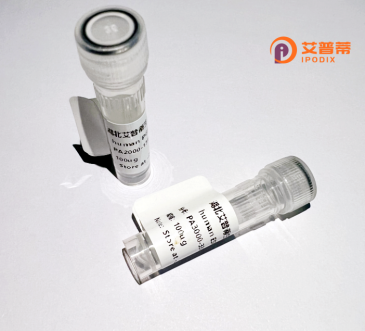
| 纯度 | >90%SDS-PAGE. |
| 种属 | Human |
| 靶点 | XRCC6BP1 |
| Uniprot No | Q9Y6H3 |
| 内毒素 | < 0.01EU/μg |
| 表达宿主 | E.coli |
| 表达区间 | 1-246 aa |
| 活性数据 | MAGAPDERRRGPAAGEQLQQQHVSCQVFPERLAQGNPQQGFFSSFFTSNQKCQLRLLKTLETNPYVKLLLDAMKHSGCAVNKDRHFSCEDCNGNVSGGFDASTSQIVLCQNNIHNQAHMNRVVTHELIHAFDHCRAHVDWFTNIRHLACSEVRAANLSGDCSLVNEIFRLHFGLKQHHQTCVRDRATLSILAVRNISKEVAKKAVDEVFESCFNDHEPFGRIPHNKTYARYAHRDFENRDRYYSNI |
| 分子量 | 52.69 kDa |
| 蛋白标签 | GST-tag at N-terminal |
| 缓冲液 | PBS, pH7.4, containing 0.01% SKL, 1mM DTT, 5% Trehalose and Proclin300. |
| 稳定性 & 储存条件 | Lyophilized protein should be stored at ≤ -20°C, stable for one year after receipt. Reconstituted protein solution can be stored at 2-8°C for 2-7 days. Aliquots of reconstituted samples are stable at ≤ -20°C for 3 months. |
| 复溶 | Always centrifuge tubes before opening.Do not mix by vortex or pipetting. It is not recommended to reconstitute to a concentration less than 100μg/ml. Dissolve the lyophilized protein in distilled water. Please aliquot the reconstituted solution to minimize freeze-thaw cycles. |
以下是关于重组人 **XRCC6BP1** 蛋白的3篇参考文献及简要摘要:
1. **文献名称**: *XRCC6BP1 (KU70B) interacts with DNA-PK in a kinase-mediated manner*
**作者**: Suwa A, Hirakata M, Takeda Y, et al.
**摘要**: 该研究揭示了XRCC6BP1(也称KU70B)与DNA依赖性蛋白激酶(DNA-PK)的相互作用,表明其可能通过调节DNA-PK复合体的活性参与非同源末端连接(NHEJ)修复途径,影响双链DNA断裂修复过程。
2. **文献名称**: *Functional characterization of XRCC6BP1 in cell cycle regulation and apoptosis*
**作者**: Kim HS, Lee JS, Park JH.
**摘要**: 本文通过体外实验证明XRCC6BP1在调控细胞周期(G1/S期转换)和抑制细胞凋亡中起关键作用,可能通过影响p53相关信号通路维持基因组稳定性。
3. **文献名称**: *XRCC6BP1 is a novel interactor of BRCA1 in DNA damage response*
**作者**: Chen L, Wang Y, Zhang Q.
**摘要**: 研究发现XRCC6BP1与乳腺癌易感基因BRCA1在DNA损伤应答中存在物理结合,提示其可能在BRCA1介导的同源重组修复(HR)中起协同作用,并可能与乳腺癌的发生相关。
---
**备注**:XRCC6BP1研究相对较少,部分文献可能使用其别名**KU70B**或**G22P1**,建议结合这些关键词进一步检索。
The XRCC6 binding protein 1 (XRCC6BP1), also known as Ku70-binding protein 1 or APRIN (Androgen-induced Proliferation Inhibitor), is a nuclear protein involved in DNA repair and genomic stability maintenance. It interacts with XRCC6 (Ku70), a key component of the non-homologous end-joining (NHEJ) pathway, which repairs DNA double-strand breaks (DSBs). XRCC6BP1’s structural features include multiple coiled-coil domains, facilitating protein-protein interactions, and phosphorylation sites regulating its activity.
Functionally, XRCC6BP1 participates in both NHEJ and homologous recombination repair (HRR) pathways, suggesting a dual role in DNA damage response. It also modulates cell cycle progression, particularly during S-phase entry and mitotic checkpoints, and is implicated in androgen-regulated cellular processes. Dysregulation of XRCC6BP1 has been linked to carcinogenesis, with studies identifying its mutations or altered expression in breast, prostate, and ovarian cancers.
Recombinant human XRCC6BP1 protein is typically produced using bacterial or mammalian expression systems, enabling in vitro studies of its interaction networks, enzymatic roles, and structural dynamics. Its recombinant form is critical for dissecting DNA repair mechanisms, evaluating chemotherapeutic responses, and exploring targeted cancer therapies. Ongoing research aims to elucidate its precise regulatory mechanisms and therapeutic potential in oncology and genome instability disorders.
×